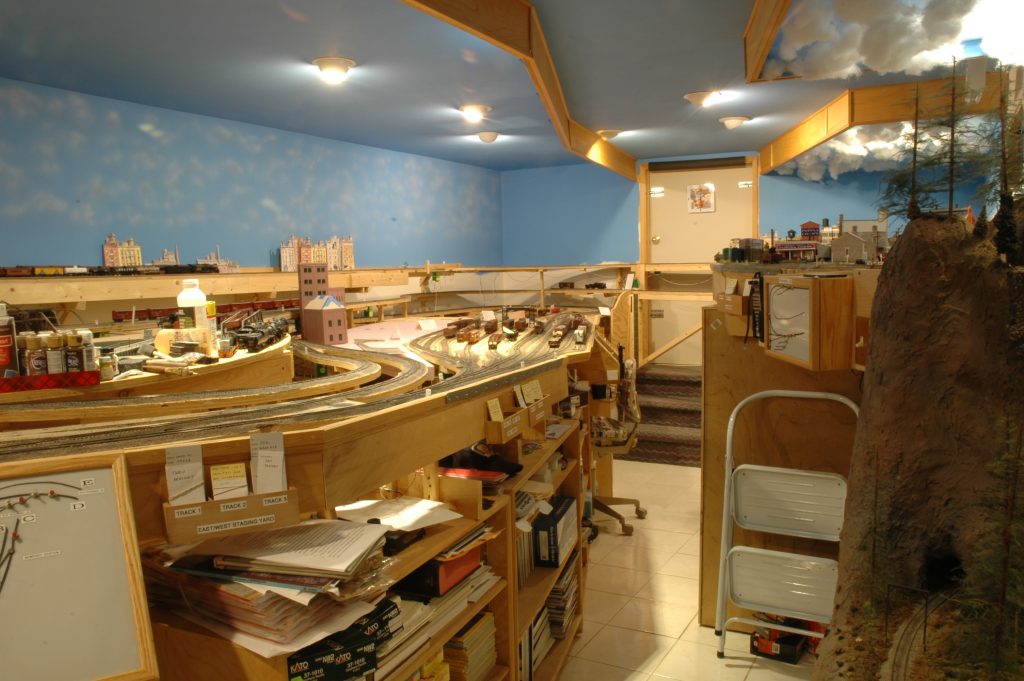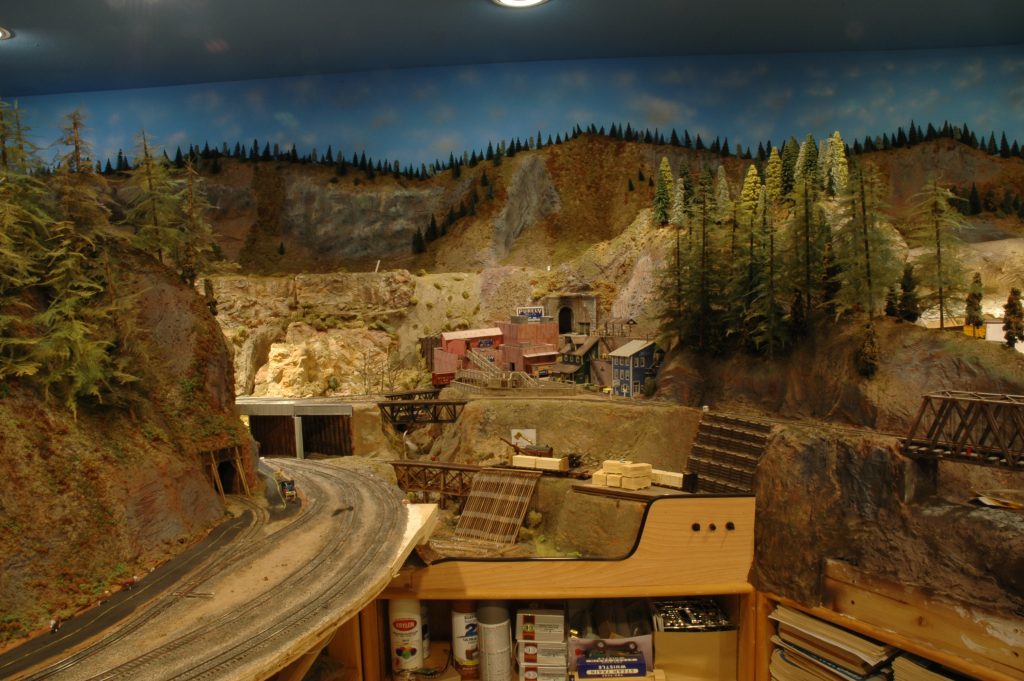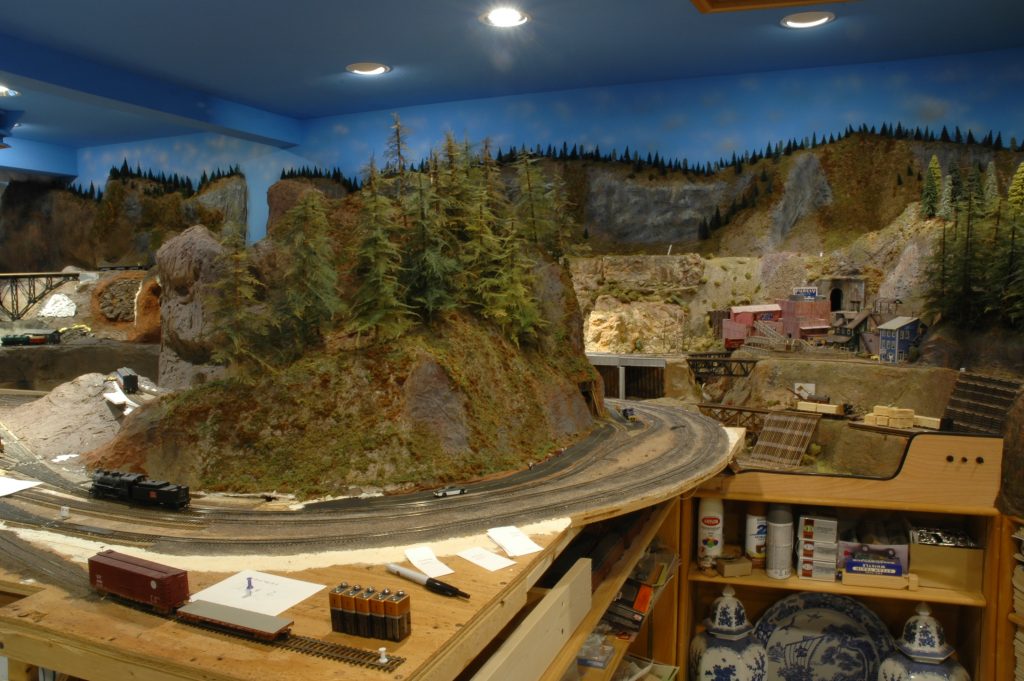By David Yadock
Dry Gulch & Western – A Photo Series Part 4
Continuing along with this series about the Dry Gulch & Western I’ll explain one of the scenery techniques I used for the layout. I decided early on to use some “old school” techniques. Due to the size of the layout and various cost considerations I used the tried and true method of chicken wire and plaster. I started with a rough frame using dimensional pine boards. That created the contours of the mountains. I then covered the wood framework with chicken wire to further form the shapes of the mountains. After that was done, I draped plaster-soaked Crown C-fold paper towels to the wire. Some of that work was difficult to accomplish since many of the mountains are very vertical. Once that plasterwork was done, I added more plaster to cover the paper towels. This added more strength and texture to the mountains. The plaster I used was standard Hydrocal plaster. The one issue I encountered was that it is very quick drying and would usually set within about 20 minutes. So, the plaster work had to be done in small batches. I would speed up the entire process by using multiple aluminum turkey roasting pans to mix the small batches of plaster. These are inexpensive and very flexible. The flexibility of the pan allowed for easy cleaning. They were also large enough to allow the paper towels to be dipped into the thin plaster. I used around 8 pans at a time and by the time I got to using the 8th pan the plaster in the first pan was completely dry and could be cleaned out just by flexing the sides of the pan. I could usually do about 15-20 batches in an evening! By the way, there was around 900 pounds of plaster used for the mountains. Now, lets see some more of the layout.

Photo 16 gives you a view of the aisle that you just walked down in the previous photo set. Allentown is on the right of the aisle and Newport is on the left. This photo gives a really nice shot of the Newport yard and the shipping basin tracks. It also shows the small control panel for Allentown on the right.

Photo 17 shows the small wooded bridge on the way to Gornitzka Crossing. It is a Campbell kit. At Gornitzka Crossing you will find a sawmill operation (only the log off-loading and finished lumber loading areas are on the layout), a stockyard, and a meat processing plant. As mentioned earlier in this series there is a bi-level station fashioned after John Allen’s station at Corsa/Cross Junction. My station copies the same station naming idea by having the lower station named Gornitzka Crossing and the upper part of the station named Hunter’s Glen. The blue building in the photo is Scole’s Hideout, a speakeasy of sorts. The tall timber trees in the center of the photo are constructed using Jack Work’s method of making trees. Each tree takes about 2 hours to construct. To the right of those trees is the Ellison main yard. The hill and forest functions as a view block.

Photo 18 shows a more expansive view of Gornitzka Crossing. Some of the scenery in this area was originally on Paul Scole’s layout. I was able to salvage some of it and place it on my layout. That was very challenging. The tracks on the left are the mainline to the town of Dry Gulch. The wooden tunnel portal on the left allows a narrow-gauge line to join up with the standard gauge mainline.

Photo 19 gives a better view of the narrow-gauge tunnel portal and the mountainous scenery to come. Yes, the mountain on the left is another view block. If you look closely you will be able to see the town of Alpine at the top of the photo.

Photo 20 gives a more panorama view of the overall scene. We are almost ready to enter Dry Gulch; it is on the bottom left out of view. This photo shows yet another forest of tall timber trees. You can also see a hint of one of my largest bridges in the distance on the extreme left. The mountain in this photo completely hides the town of Alpine that resides against the upper back wall of the layout.
Next time we will enter Dry Gulch, the namesake town of the layout. There will be even more views of the mountains and some of the many bridges that traverse them.

David, it’s just amazing to see how much progress you have made in just a few years. And it’s not as if you haven’t done anything else: Pacific Science Center show, helping other modelers and more. . .